
Hemimorphite is the chemical compound Zn4(Si2O7)(OH)2·H2O, a component of mineral calamine. It is a silicate mineral which, together with smithsonite (ZnCO3), has been historically mined from the upper parts of zinc and lead ores. Both compounds were originally believed to be the same mineral and classified as calamine. In the second half of the 18th century, it was discovered that these two different compounds were both present in calamine. They closely resemble one another.

Germanite is a rare copper iron germanium sulfide mineral, Cu26Fe4Ge4S32. It was first discovered in 1922, and named for its germanium content. It is only a minor source of this important semiconductor element, which is mainly derived from the processing of the zinc sulfide mineral sphalerite. Germanite contains gallium, zinc, molybdenum, arsenic, and vanadium as impurities.

Vanadinite is a mineral belonging to the apatite group of phosphates, with the chemical formula Pb5(VO4)3Cl. It is one of the main industrial ores of the metal vanadium and a minor source of lead. A dense, brittle mineral, it is usually found in the form of red hexagonal crystals. It is an uncommon mineral, formed by the oxidation of lead ore deposits such as galena. First discovered in 1801 in Mexico, vanadinite deposits have since been unearthed in South America, Europe, Africa, and North America.

Rhodochrosite is a manganese carbonate mineral with chemical composition MnCO3. In its pure form (rare), it is typically a rose-red colour, but it can also be shades of pink to pale brown. It streaks white, and its Mohs hardness varies between 3.5 and 4.5. Its specific gravity is between 3.45 and 3.6. The crystal system of rhodochrosite is trigonal, with a lattice structure and cleavage in the carbonate rhombohedral system. The carbonate ions (CO2−
3) are arranged in a triangular planar configuration, and the manganese ions (Mn2–) are surrounded by six oxygen ions in an octahedral arrangement. The MnO6 octahedra and CO3 triangles are linked together to form a three-dimensional structure. Crystal twinning is often present. It can be confused with the manganese silicate rhodonite, but is distinctly softer. Rhodochrosite is formed by the oxidation of manganese ore, and is found in South Africa, China, and the Americas. It is one of the national symbols of Argentina.
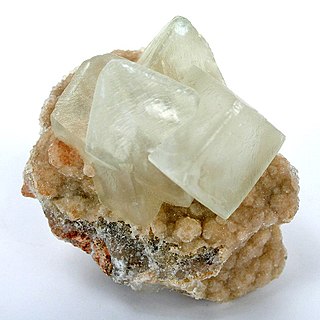
Smithsonite, also known as zinc spar, is the mineral form of zinc carbonate (ZnCO3). Historically, smithsonite was identified with hemimorphite before it was realized that they were two different minerals. The two minerals are very similar in appearance and the term calamine has been used for both, leading to some confusion. The distinct mineral smithsonite was named in 1832 by François Sulpice Beudant in honor of English chemist and mineralogist James Smithson (c. 1765–1829), who first identified the mineral in 1802.

Cuprite is an oxide mineral composed of copper(I) oxide Cu2O, and is a minor ore of copper.
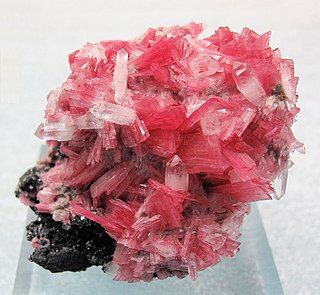
Rhodonite is a manganese inosilicate, with the formula (Mn, Fe, Mg, Ca)SiO3, and member of the pyroxenoid group of minerals, crystallizing in the triclinic system. It commonly occurs as cleavable to compact masses with a rose-red color (its name comes from Ancient Greek ῥόδον (rhódon) 'rose'), often tending to brown due to surface oxidation. The rose-red hue is caused by the manganese cation (Mn2+).

Mimetite is a lead arsenate chloride mineral (Pb5(AsO4)3Cl) which forms as a secondary mineral in lead deposits, usually by the oxidation of galena and arsenopyrite. The name derives from the Greek Μιμητής mimetes, meaning "imitator" and refers to mimetite's resemblance to the mineral pyromorphite. This resemblance is not coincidental, as mimetite forms a mineral series with pyromorphite (Pb5(PO4)3Cl) and with vanadinite (Pb5(VO4)3Cl). Notable occurrences are Mapimi, Durango, Mexico and Tsumeb, Namibia.

Tephroite is the manganese endmember of the olivine group of nesosilicate minerals with the formula Mn2SiO4. A solid solution series exists between tephroite and its analogues, the group endmembers fayalite and forsterite. Divalent iron or magnesium may readily replace manganese in the olivine crystal structure.

Tsumeb is a city of 15,000 inhabitants and the largest town in the Oshikoto region in northern Namibia. Tsumeb is known as the "gateway to the north" of Namibia. It is the closest town to the Etosha National Park. Tsumeb used to be the regional capital of Oshikoto until 2008 when Omuthiya was proclaimed a town and the new capital. The area around Tsumeb forms its own electoral constituency and has a population of 44,113. The town is the site of a deep mine that in its heyday was known as "TCL", but has since been renamed the Ongopolo Mine.
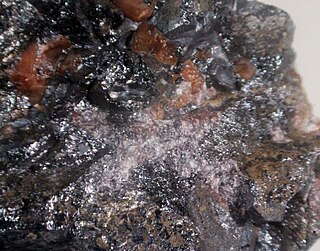
The rare mineral adelite, is a calcium, magnesium, arsenate with chemical formula CaMgAsO4OH. It forms a solid solution series with the vanadium-bearing mineral gottlobite. Various transition metals substitute for magnesium and lead replaces calcium leading to a variety of similar minerals in the adelite–duftite group.
Schreyerite (V2Ti3O9), is a vanadium, titanium oxide mineral found in the Lasamba Hill, Kwale district in Coast Province, Kenya. It is polymorphous with kyzylkumite.

Duftite is a relatively common arsenate mineral with the formula CuPb(AsO4)(OH), related to conichalcite. It is green and often forms botryoidal aggregates. It is a member of the adelite-descloizite Group, Conichalcite-Duftite Series. Duftite and conichalcite specimens from Tsumeb are commonly zoned in color and composition. Microprobe analyses and X-ray powder-diffraction studies indicate extensive substitution of Zn for Cu, and Ca for Pb in the duftite structure. This indicates a solid solution among conichalcite, CaCu(AsO4 )(OH), austinite, CaZn(AsO4)(OH) and duftite PbCu(AsO4)(OH), all of them belonging to the adelite group of arsenates. It was named after Mining Councilor G Duft, Director of the Otavi Mine and Railroad Company, Tsumeb, Namibia. The type locality is the Tsumeb Mine, Tsumeb, Otjikoto Region, Namibia.
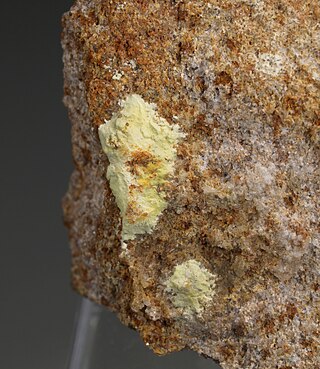
Coconinoite is a uranium ore that was discovered in Coconino County, Arizona. It is a phosphate mineral; or uranyl phosphate mineral along with other subclass uranium U6+ minerals like blatonite, boltwoodite, metazeunerite and rutherfordine.

Tsumcorite is a rare hydrated lead arsenate mineral that was discovered in 1971, and reported by Geier, Kautz and Muller. It was named after the TSUMeb CORporation mine at Tsumeb, in Namibia, in recognition of the Corporation's support for mineralogical investigations of the orebody at its Mineral Research Laboratory.
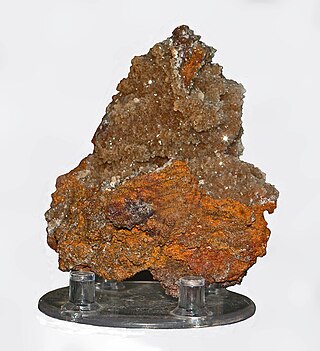
Tarbuttite is a rare phosphate mineral with formula Zn2(PO4)(OH). It was discovered in 1907 in what is now Zambia and named for Percy Coventry Tarbutt.

Huemulite is a mineral with formula Na4Mg(V10O28)·24H2O that is yellow to orange in color. It was first discovered in Argentina in 1959 and described in 1966. The mineral is named for the Huemul mine in which it was discovered.
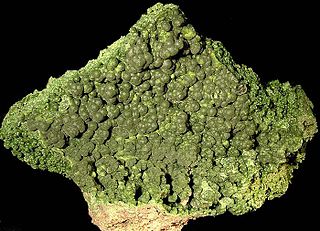
Mottramite is an orthorhombic anhydrous vanadate hydroxide mineral, PbCu(VO4)(OH), at the copper end of the descloizite subgroup. It was formerly called cuprodescloizite or psittacinite (this mineral characterized in 1868 by Frederick Augustus Genth). Duhamelite is a calcium- and bismuth-bearing variety of mottramite, typically with acicular habit.

Queitite is a lead zinc silicate sulphate that was named after the mineral dealer Clive S. Queit, who collected the first specimens. It got approved by the IMA in 1979, and it is an extremely rare secondary mineral.

Arsendescloizite is a lead-zinc mineral, approved by the IMA in 1982. It is an arsenate analog of descloizite. Its first description was published in 1982.




















